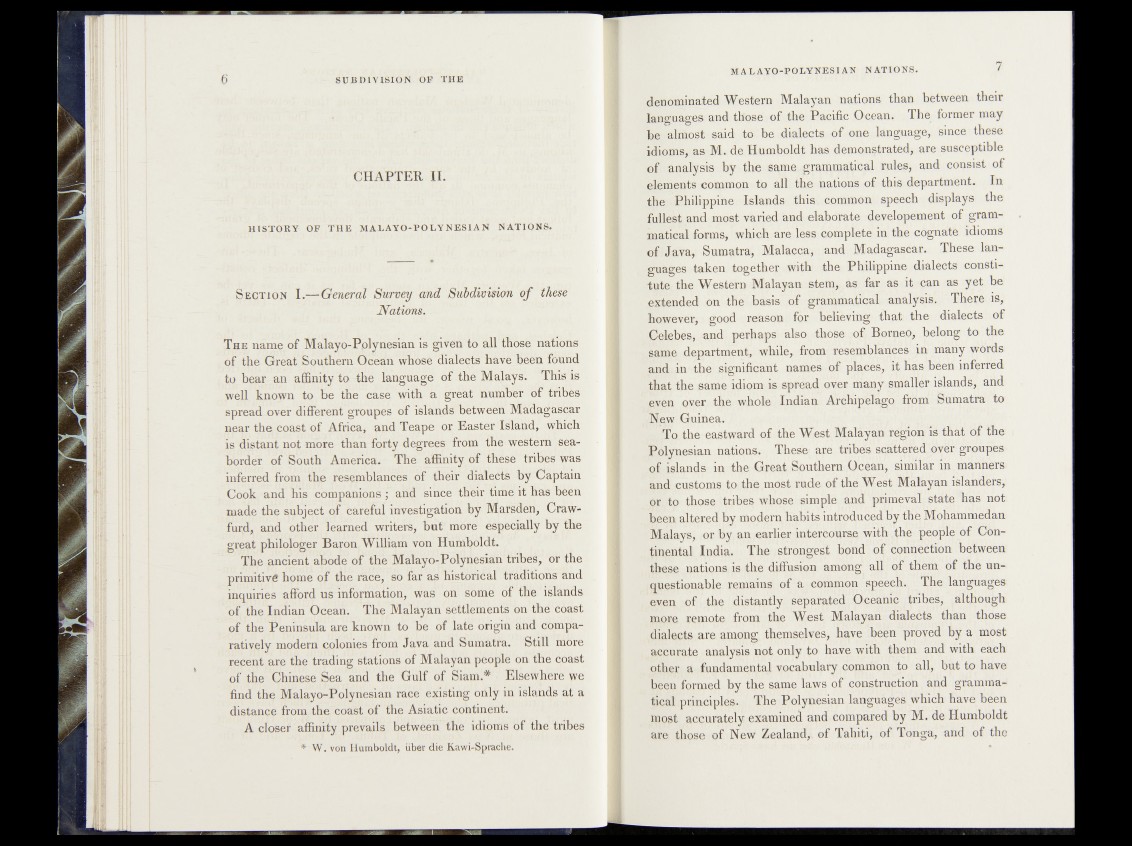
CHAPTER II.
HISTORY OF THE MALAYO-FOLYNESIAN NATIONS.
Section I.-—General Survey ana Subdivision o f these
Nations.
The name of Malayo-Pplynesian is given to all those nations
of the Great Southern Ocean whose dialects have been found
to bear an affinity to.-4be language of-the Malays! This is
well known to fee the case with a great number - of tribes
spread over different groupes of islands between Madagksbar
near the coast of Africa, and Teape or Easter Island, which
is distant not more than forty degrees- from the western sea-
border of South America. The affinity of these tribes was
inferred from the resemblances of -their dialects by Captain
Cook and his companions ; and since their time it has been
made the subject of careful investigation by Marsden, Craw-
furd, and other learned writers, but more especially by the
great philologer Baron William von Humboldt. r
The ancient abode of the Malayo-Polynesian tribes, or fhe
primitive home of the race, so far as historical traditions and
inquiries afford us information, was on some of the islands
of the Indian Ocean. The Malayan settlements on the coast
of the Peninsula are known to be of late origin and comparatively
modern colonies from Java and Sumatra. Still more
recent are the trading stations of Malayan people on the coast
of the Chinese Sea and the Gulf of Siam.* Elsewhere we
find the Malayo-Polynesian race existing oiily in islands at a
distance from the coast of the Asiatic continent.
A closer affinity prevails between the idioms of the tribes
* W. von Humboldt, iiber die Kawi-Sprache.
denominated Western Malayan nations than between their
languages and those -of the Pacific Ocean. The former may
be'-almost said to ’be dialects of one language, since these
idioms, as M..d,e Humboldt has demonstrated, are susceptible
©f analysis by the same grammatical rules, and consist of
elements common to all the nations of this department. In
the Philippine Islands this^ common speech displays the
fullest and most varied and elaborate developement of grammatical
forms, which are less complete in the cognate idioms
of Java, Sumatra, Malacca, and Madagascar. These languages
taken together with the Philippine dialects constitute
the Western Malayan stem, as far as ifecan as yet be
extended on the basis of grammatical analysis. There is,
however, good reason for believing that, the dialects of
Celebes, and perhaps also those of, Borneo, belong to the
game department, while, from resemblances in many words
and. in the significant names of places, it has been inferred
that the same idiom is spread over many smaller islands, and
given over the whole Indian Archipelago from Sumatra to
.jtpw Guinea.
To the eastward of the N e s t Malayan region is that of the
Polynesian nations. These- are tribes scatt^red^dyer groupes
of islands in the Great Southern Ocean, similar in manners)
and; customs to the most rude of the West Malayan islanders,
6r tp those tribes whose simple and primeval state has not
been altered by modern habits introduced by tub Mohammedan
Malays, or by an earlier int^cobrse, with the people , of Continental
India. The strongest bond of eonnection between
these nations is the diffusion among all of them of the unquestionable
remains of a common speech. The languages
even of the distantly separated Oceanic s tribes, although
more remote from the West Malayan dialects than those
dialects are among themselves, have ffiêen proved By a most
accurate analysis not only to have with them and with each
other a fundamental vocabulaty coppiion to all, but to have
been formed hy the same laws of constsuftion and gramma™
tical principles. The Polynesian languages which have beeh.
most accurately examined and compared by M. de Humboldt
are those of New Zealand,, of Tahiti, of Tonga, and of the